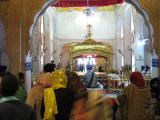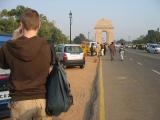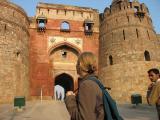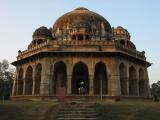maïte & hugues
around the world
Tracking
Our last access to this website was 5 years 2 weeks ago.
Search
Countries
- India
- Nepal
- Vietnam
- Laos
- Thailand
- Cambodia
- Australia
- New Zealand
- Peru
- Bolivia
- Chile
- Argentina
Singh
2006-12-13
 This morning we decide to go visit the old Red Fort, situated in Old Delhi. We leave the hostel and dare to film outside for the first time. Nobody pays any attention to the camera, so everything is OK.
This morning we decide to go visit the old Red Fort, situated in Old Delhi. We leave the hostel and dare to film outside for the first time. Nobody pays any attention to the camera, so everything is OK.
We get in an auto-rickshaw. The driver’s called Singh and is a 60 years old Sikh. He explains to us that he lived in California and that now that he is back in his country, he owns a taxi and auto-rickshaw company. He kindly suggests taking us to visit a Sikh temple. We agree and he drives us there.
 When we get there, we have to take off our shoes. It’s great to be barefoot on the marble around the temple, it’s a totally different feeling than with shoes. After we both wash our hands and feet and cover our heads, we enter the temple. There are lots of people (only Indians) in and around it.
When we get there, we have to take off our shoes. It’s great to be barefoot on the marble around the temple, it’s a totally different feeling than with shoes. After we both wash our hands and feet and cover our heads, we enter the temple. There are lots of people (only Indians) in and around it.
A nice relaxing music surrounds the temple. While entering, we are surprised to find out that the music is sung and played by a few people, in the middle of the temple. Singh explains to us that it is the text of the sacred book the Sikhs, the “Guru Granth Sahib”.
 We then leave the temple and, still barefoot, we follow Singh who shows us volunteers that cook the free food given away in the temple. This is one of the principles of the Sikhism. We each receive a chapatti (a small flat Indian bread), and some brown dough, based on water, flour and other things we don’t quite recall.
We then leave the temple and, still barefoot, we follow Singh who shows us volunteers that cook the free food given away in the temple. This is one of the principles of the Sikhism. We each receive a chapatti (a small flat Indian bread), and some brown dough, based on water, flour and other things we don’t quite recall.
We get our shoes back and leave the temple area. Singh gets us in a friend’s taxi and suggests to show us other interesting places in New Delhi for free. He then explains that he has a deal with local shopkeepers, to whom he has to bring tourists in exchange for a commission. We don’t have to buy anything, it’s all the same to him. So between visits, we have to put up with entering tourist shops more and more expensive and to learn how to get rid of insistent sellers.
 We arrive at the “Rashtrapati Bhavan”. From Lonely Planet – North India (2005) (French edition):
We arrive at the “Rashtrapati Bhavan”. From Lonely Planet – North India (2005) (French edition):
Residence of the (British) viceroy before the independence, the Rashtrapati Bhavan is today the official residence of the president of India. Its construction ended in 1929, this “palace” being a mix of Mughal and Occidental styles. (…) In the times of Mountbatten, the last viceroy of India, the maintenance of all 340 rooms of the palace and its huge garden required an army of people. Among the 418 gardeners, 50 boys were responsible with keeping birds away.
 In front of this palace lies the “Rajpath”, the Indian “Champs Élysées”. At its end stands the “India Gate”, a stone arch 42 meter tall.
In front of this palace lies the “Rajpath”, the Indian “Champs Élysées”. At its end stands the “India Gate”, a stone arch 42 meter tall.
Afterwards, we are taken to the “Purana Qila”, an old fort surrounded by a lake.
 We then visit the “Lodi Garden”, a nice calm park, with rather few people. It houses the tomb of kings to which lead palm tree alleys.
We then visit the “Lodi Garden”, a nice calm park, with rather few people. It houses the tomb of kings to which lead palm tree alleys.
Finally, we enter the gigantic precinct of the magnificent tomb of Safdarjang. We witness the setting of the sun, which spreads a spectacular light.
 Feeling quite tired and starving, we head back for our hostel, where we find Dan the American who leaves New Delhi tomorrow. We say goodbye, after exchanging our coordinates.
Feeling quite tired and starving, we head back for our hostel, where we find Dan the American who leaves New Delhi tomorrow. We say goodbye, after exchanging our coordinates.
We then go to the Sonu Chat House for dinner, where we both enjoy some “slightly” spicy Indian dishes.
It’s the end of our second day in Delhi. We didn’t manage to visit the Red Fort, but we start to get used to this new environment.
This text has been voluntarily translated from French by Cristina Lumezeanu. Big thanks to her! If you think there is a translation mistake, don’t hesitate to contact us.

Recent comments
15 years 44 weeks ago
15 years 45 weeks ago
15 years 48 weeks ago
15 years 49 weeks ago
16 years 2 weeks ago
16 years 13 weeks ago
16 years 16 weeks ago
16 years 23 weeks ago
16 years 23 weeks ago
16 years 23 weeks ago